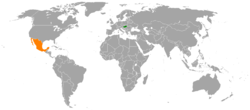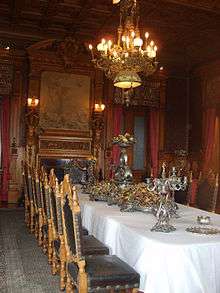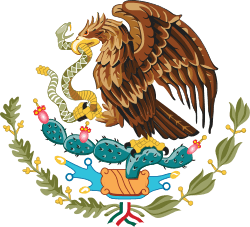Hungary–Mexico relations
 |
|
Hungary |
Mexico |
|---|---|
Hungary–Mexico relations refer to foreign relations between Hungary and Mexico. Relations date back to the short reign of the Emperor Maximilian I of Mexico from 1864 to 1867. Diplomatic relations with Austria–Hungary were established in 1901, but were suspended between 1941 and 1974. They were re-established on May 14, 1974.[1] The Mexican embassy in Budapest was opened on September 30, 1976.
History

Paprika, a key ingredient in Hungarian dishes such as Goulash, originated in Mexico and was perhaps brought to Hungary by way of Turkey in the 17th century.[2]
The Emperor Maximilian I of Mexico, who ruled from 1864 to 1867, was brother of Franz Joseph I, Emperor of Austria and King of Hungary.[3] Maximilian I resided in Chapultepec Castle while in Mexico City; it now serves as a museum that featuring furnishings and artwork from 1860s Austria-Hungary.[4]
After the First World War, the Austro-Hungarian mission was liquidated. When relations resumed, the first Hungarian representative in Mexico was Count László Széchenyi, also head of the Washington, D.C. legation, who first visited Mexico in 1925.[5] Relations were again suspended during the Second World War, and Mexico did not resume relations with Hungary until May 14, 1974. In May 2009, the two countries celebrated 35 years of continuous relations since that date.[6]
High level visits
In 1977, Pál Losonczi, Head of the Presidential Council of the People's Republic of Hungary visited Mexico. In April 1990, the Chancellor of Mexico Fernando Solana paid an official visit to Hungary. In October 1991 the State Secretary of the Hungarian Foreign Ministry, Ferenc Somogyi visited Mexico. The Hungarian Minister of Foreign Affairs Géza Jeszenszky visited Mexico in March 1992. In July 1992, President Carlos Salinas de Gortari made the first state visit by a Mexican president to Hungary.[7]
At the start of 1997, the Hungarian State Secretary of Foreign Affairs István Szent-Iványi visited Cuba and Mexico.[8] In April 1997, President Árpád Göncz of Hungary paid a state visit to Mexico, the first since relations had been reestablished, meeting Mexican President Ernesto Zedillo.[9] In November 2001, Prime Minister Viktor Orbán visited Mexico, where he attended a meeting of Leaders of Christian-Democratic Parties.[7] In 2004, Mexican President Vicente Fox visited Hungary to discuss a future economic cooperation agreement that would boost economic and trade relations.[10]
Agreements
- In April 1975 the two countries signed a trade agreement.[11]
- In February 1977 Mexico and Hungary signed an agreement on scientific and technical cooperation.[12]
- In 1997 the presidents of the two countries signed agreements to foster cooperation between their diplomatic corps, on air transportation, education, culture, investments.[9]
Economic relations
During the 1960s and 1970s, Hungarian exports to Latin America accounted for over 6% of Hungary's total exports, supplying low-cost but reasonable-quality manufactured goods and medicines. Exports declined greatly from that peak in the 1980s and 1990s. However, from a low of about US$5 million in 1990, trade with Mexico has expanded steadily.[13] In April 1997, President Göncz stressed the future of bilateral trade, which he said had quadrupled over the last two years to US$22.8 million, with Hungarian exports totaling US$6.1 million.[9] Another sources gives 1996 Hungarian exports, mainly machinery, at somewhat below US$7 million, while Mexican imports amounted to US$29 million.[8] In 2004, Gyula Németh, Hungarian ambassador to Mexico, said he expected relations between Mexico and Hungary to grow even stronger after Hungary joined the European Union later that year. He noted that Mexico was already the second-most important Latin American trade partner for Hungary.[10] By 2014, Hungarian exports to Mexico totaled US$983 million and imports from Mexico totaled US$192 million totaling to US$1,176 billion.[14]
Cultural and scientific links
Perhaps the most famous Mexican of Hungarian descent was the painter Frida Kahlo, wife of Diego Rivera.[15] The Hungarian Géza Maróti contributed the bronze sculpture group on top of the dome of the Palacio de Bellas Artes and other works inside this building, completed in 1934.[16] Gunther Gerzso, another Mexican of Hungarian descent, was a painter, designer and director and screenwriter for film and theatre.[17] Jorge Mester, a conductor and violinist was born in Mexico City to parents who had emigrated from Hungary. He has conducted many of the world's leading ensembles, including the Boston Symphony, the Detroit Symphony, and the Royal Philharmonic Orchestra.[18] George Rosenkranz, born in Hungary in 1916, is a prominent scientist in steroid research who spent most of his life in Mexico.[19]
Resident diplomatic missions
- Hungary has an embassy in Mexico City.[20]
- Mexico has and embassy in Budapest.[21]
References
- ↑ History of diplomatic relations between Mexico and Hungary (in Spanish)
- ↑ "Paprika (Capsicum annuum L.)". Gernot Katzer’s Spice Pages. Retrieved 2009-08-12.
- ↑ Joan Haslip (1971). The crown of Mexico: Maximilian and his Empress Carlota. Holt, Rinehart and Winston. ISBN 0-03-086572-7.
- ↑ "Museo Nacionale de Historia" (in Spanish). Retrieved 2009-08-12.
- ↑ "HUNGARY: Mexican Relations". Time Inc. Jun 1, 1925. Retrieved 2009-08-12.
- ↑ "MÉXICO Y HUNGRÍA CELEBRAN EL XXXV ANIVERSARIO DEL RESTABLECIMIENTO DE RELACIONES DIPLOMÁTICAS" (in Spanish). Diplomacy Monitor. 19 May 2009.
- 1 2 "Relaciones México-Hungría" (PDF) (in Spanish). Embajada de México, República de Hungría. Retrieved 2009-08-12.
- 1 2 "Hungary Seeks Closer Ties with Latin America". PERMANENT MISSION OF THE REPUBLIC OF HUNGARY TO THE UNITED NATIONS. May 9, 1997. Retrieved 2009-08-12.
- 1 2 3 "State Visit by the President of Hungary". Presidency of the Republic of Mexico. April 15, 1997. Retrieved 2009-08-12.
- 1 2 "Mexico to form tighter relations with Hungary.". Internet Securities. April 13, 2004. Retrieved 2009-08-12.
- ↑ "Mexico and Hungary Trade Agreement" (PDF). United Nations. 28 April 1975. Retrieved 2009-08-12.
- ↑ "Mexico and Hungary Agreement on Scientific and Technical Cooperation" (PDF). United Nations. 7 February 1977. Retrieved 2009-08-12.
- ↑ "Short review of the economic and trade relationships between Hungary and Latin America (1990-2004)". GestioPolis. 2009-02-16. Retrieved 2009-08-12.
- ↑ Mexican Ministry of the Economy: Hungary (in Spanish)
- ↑ "Frida Kahlo (1907-1954), Mexican Painter". FridaKahlo.com. Retrieved 2009-08-12.
- ↑ "The Bellas Artes Palace". Explorando Mexico. Retrieved 2009-08-12.
- ↑ "Gunther Gerszo". IMDB - Internet Movie Database. Retrieved 2009-08-12.
- ↑ "Jorge Mester, conductor". Naxos Digital Services Ltd. Retrieved 2009-08-12.
- ↑ "Mexico's Pill Pioneer". Pan American Health Organization. Retrieved 2009-08-12.
- ↑ Embassy of Hungary in Mexico City (in Hungarian and Spanish)
- ↑ Embassy of Mexico in Budapest (in English, Hungarian and Spanish)

